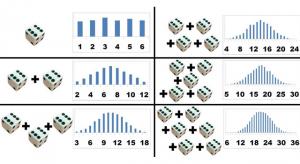All Features

Donald J. Wheeler
Short Run SPC, Part 1 and Part 2 showed how to use zed charts and difference charts to track the underlying process while making different products. This part will illustrate both the robustness of the zed chart and an incorrect way of standardizing the data from the different products.
The…

Davis Balestracci
Editor’s note: The following browsable offering from Davis Balestracci represents a good chunk of his knowledge base. If you’re looking for improvement ideas, motivation, or a swift kick in the pants for yourself or your team, you’ll find them in this collection of his most popular columns.
In the…

Donald J. Wheeler
Lean production is built on the explicit assumption that each step is operated predictably and capably. Predictable operation can only be achieved and maintained by using process behavior charts. But short production runs make it hard to see how to use process behavior charts in a lean environment…

Dirk Dusharme @ Quality Digest
What a year.
No matter your job, your industry, or your political beliefs, this year has been a heck of a ride. The (still ongoing) trade war with China, manufacturing gains (and losses), the 737 MAX, Hong Kong riots, North Korea, Brexit, impeachment. What a mixed bag of ups and downs that has…

As usual with Quality Digest’s diverse audience, this year’s top stories covered a wide range of topics applicable to quality professionals. From hardware to software, from standards to risk management, from China trade to FDA regulations. It’s always fun to see what readers gravitate to, and this…

Donald J. Wheeler
Lean production is built on the explicit assumption that each step is operated predictably and capably. Predictable operation can only be achieved and maintained by using process behavior charts. But short production runs and multiple products make it hard to see how to use process behavior charts…

Harish Jose
It has been a while since I have written about statistics, and I get asked a lot about a way to calculate sample sizes based on reliability and confidence levels. So today I am sharing a spreadsheet that generates an operating characteristic (OC) curve based on your sample size and the number of…

Donald J. Wheeler
In the past two months we have looked at how three-sigma limits work with skewed data. This column finds the power functions for the probability limits of phase two charts with skewed probability models, and compares the trade-offs made by three-sigma limits with the trade-offs made by the…

Jody Muelaner
One of the key ideas in lean manufacturing is that defects should be detected as early as possible. Efforts to control manufacturing processes, so that issues can be detected before defects occur, actually predate lean. Statistical process control (SPC) is a set of methods first created by Walter A…

Bill Snyder
In 1500, China’s economy was the strongest in the world. But by the 19th century, the United States, Western Europe, and Japan had leapfrogged over China by churning out goods and services in vast quantities while the former superpower stalled.
Why? Some economists argue that China’s lack of free…

Dr T Burns
You’ve set aside Sunday afternoon to bake some cookies, but you discover you have run out of eggs. Your partner in marital bliss has gone out and taken the car. You call a couple of mates, and they tell you to try bananas, vegetable oil, or applesauce as egg substitutes. You decide to have some fun…

Christopher Shoe
According to a recent LNS Research survey, 37 percent of quality leaders cite an inability to measure quality metrics as their No. 1 barrier to achieving quality goals. Even worse, the survey showed four in five companies have poor visibility into real-time metrics.
These figures highlight a…

Donald J. Wheeler
Last month I looked at how the fixed-width limits of a process behavior chart filter out virtually all of the routine variation regardless of the shape of the histogram. In this column I will look at how effectively these fixed-width limits detect signals of economic importance when skewed…

Yen Duong, Knowable Magazine
If you think it’s hard to tell how you’re doing at your job, imagine being a hockey goalie. Let’s say you block every shot in a game. Was that performance due to your superior skills? Or maybe just to a lack of skill in your opponents?
Evaluating ice hockey players' performance is getting easier,…

Donald J. Wheeler
The oldest myth about process behavior charts is the myth that they require “normally distributed data.” If you have ever heard this idea, or if you have ever taught this to others, then you need to read this article.
While this myth dates back to 1935, and while Walter Shewhart exposed this idea…

Steve Moore
Pickleball is arguably the fastest-growing sport in the United States, especially among baby-boomer retirees. This game is similar to tennis, but is played on a smaller court (44 ft × 20 ft) with a solid paddle and a perforated polymer ball much like a wiffle ball.
Pickleball’s popularity may be…

Davis Balestracci
As statistical methods become more embedded in everyday organizational quality improvement efforts, I find that a key concept is often woefully misunderstood, if it is even taught at all. W. Edwards Deming distinguished between two types of statistical study, which he called “enumerative” and “…

Jody Muelaner
In a general sense, capability is the ability to do something. Within manufacturing, capability is given a much more specific definition. It is an expression of the accuracy of a process or equipment, in proportion to the required accuracy.
This can be applied to production processes, in which…

Donald J. Wheeler
Recently I have had several questions about which bias correction factors to use when working with industrial data. Some books use one formula, other books use another, and the software may use a third formula. Which one is right? This article will help you find an answer.
Before we can…

Rohit Mathur
Whatever the process or type of data collected, all data display variation. This is also true in software development. Any measure or parameter of interest to our business will vary from time period to time period, e.g., number of incidents per week or month, time taken in resolving incidents,…

Donald J. Wheeler
During the past three months James Beagle and I presented columns that made extensive use of analysis of means techniques. Since these techniques may be new to some, this column explains when to use each technique and where to find tables of the appropriate scaling factors.
In 1967, Ellis R. Ott…

Romesh Saigal, Abdullah AlShelahi
Soon after the Great Recession, the U.S. stock markets plunged—and rebounded within 36 minutes. The Dow Jones Industrial Average dropped more than 9 percent, losing more than 1,000 points before suddenly recovering.
This May 6, 2010, event was the first recorded “flash crash.” Although it didn’t…

Scott A. Hindle
In everyday language, “in control” and “under control” are synonymous with “in specification.” Requirements have been met. Things are OK. No trouble.
“Out of control,” on the other hand, is synonymous with “out of specification.” Requirements have not been met. Things are not OK. Trouble.
Using…

Chad Kymal, Gregory F. Gruska
During the early 1980s, GM, Ford, and Chrysler established the Automotive Industry Action Group (AIAG), a not-for-profit organization with the mission “To improve its members’ competitiveness through a cooperative effort of North American vehicle manufacturers and their suppliers.” In the late…

Davis Balestracci
Recently, I’ve had a sad, increasing sense of déjà vu. Twitter has become even more vacuous, and LinkedIn has quickly devolved into a business version of Facebook. Literally right after I finished this draft, I read a newspaper headline: “Twitter Use Eroding Intelligence. Now there’s data to prove…